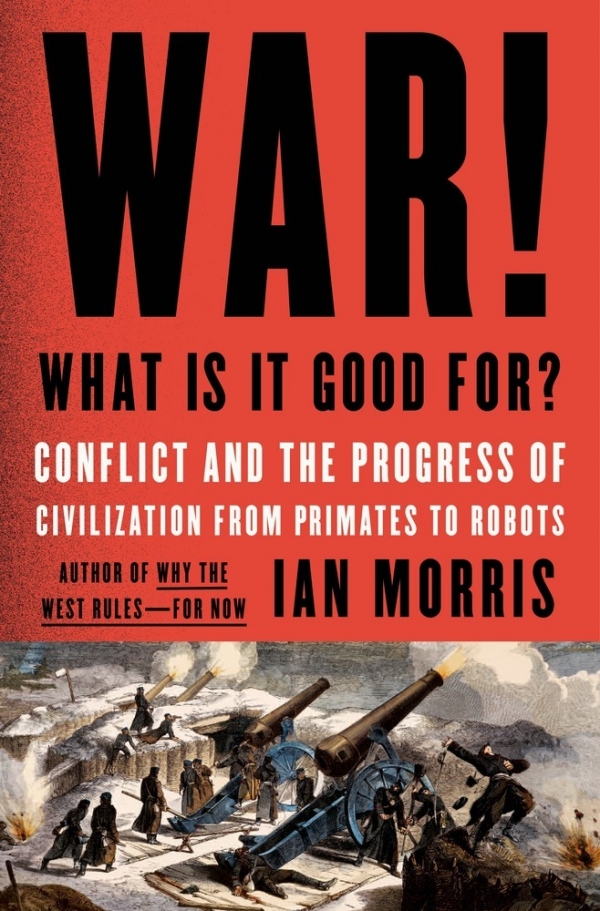"War! What is it Good for?: Conflict and the Progress of Civilization from Primates to Robots," by Ian Morris; Farrar, Straus and Giroux, New York, 2014; 512 pages; $30
Wars, Martin Luther King Jr. once said, are poor chisels for carving out peaceful tomorrows.
Ian Morris respectfully disagrees. In his latest book, "War! What is it Good for?: Conflict and the Progress of Civilization from Primates to Robots," the Stanford professor makes the opposite case. For all the gore, death and destruction, war is in fact the surest path to peace, Morris argues in his learned, engaging and highly debatable book.
"Contrary to what the song says, war has been good for something: Over the long run, it has made humanity safer and richer," Morris writes in the introduction. "War is hell, but -- again, over the long run -- the alternative would have been worse."
The book's breadth is sweeping. In describing the "long run," the Stanford archeologist, historian and biologist traverses thousands of years of human history and dozens of civilizations. In some ways, he follows the venerable tradition of works like Jared Diamond's "Guns, Germs and Steel," Samuel P. Huntington's "The Clash of Civilizations" and Francis Fukuyama's two-part "The Origins of Political Order" -- acclaimed tomes that survey the world from a high academic perch and offer broad-stroke conclusions about how we got to where we are -- and where we're going next.
Much like Morris' 2010 opus "Why the West Rules -- For Now," his new work is lucid, provocative, more than a little Eurocentric and extremely entertaining.
To bolster his argument that war is a necessary ingredient for peace, Morris cobbles together insights from history, archeology, military studies and biology, and traces the level of violence (measured in deaths per thousand residents) in societies historic and modern.
Much of the story is well-known turf for readers familiar with Diamond's work, which devotes many pages to explaining how geography, agriculture and technology largely determined which civilizations are the world's "haves" and which are the "have-nots." In Morris' book, like Diamond's, guns, germs and steel remain the major drivers of change. Geography is once again a critical determinant, with the regions located in the "lucky latitudes" (a fertile strip that extends from the Roman Empire in the west to China in the east) experiencing the joys of civilization well before other areas of the globe.
The story predictably begins with massacre. It's the year 83 A.D., and Roman legions armed with chain mail, iron shields and short swords are gleefully slaughtering thousands of Caledonians in the British highlands. By this time, the Romans have already conquered much of Europe, the Middle East and North Africa. Morris recounts a passionate pre-battle speech in which Calgacus, the leader of the Caledonians (a Celtic people), encourages his "jostling, disorderly men" to stand up to the invaders, whom he brands "the only people on earth who want to rob rich and poor alike."
"They call it stealing, killing and rape by the lying name of government! They make a wasteland and call it peace!" Calgacus shouts in a futile attempt to rally his troops.
The battle predictably ends in carnage, with about 10,000 Caledonians killed by Roman soldiers who "speared everything that moved and trampled anything that did not."
Squeamish readers may find this whole spearing business unseemly, but for Morris, the Roman blitz is the prime example of what he calls a "productive war" (one of several terms in the book that almost seem designed to make a pacifist seethe). A productive war strengthens the Leviathan of state, subdues roving bandits and turns disparate tribes into cohesive and at times prosperous societies, Morris argues. In the Middle East, for example, the Assyrian Empire became the dominant force, uniting disparate villages under one political structure before getting conquered by Persia, which in turn was defeated by Alexander the Great.
Between 10,000 and 1 B.C., most major civilizations followed the same pattern, albeit on different schedules (Mesopotamia and Asia were generally ahead of Mesoamerica and the Andes). Discovery of agriculture (which "caged" people in one location) was followed by domestication of wild horses (around 4000 B.C., on the steppes of what is now Ukraine), establishment of cities and states, development of military technology (bronze, composite bows, city fortifications and chariots) and, ultimately, the creation of empires. In China, India, Egypt and other lucky-latitude civilizations, the trend in the first few millennia B.C. was toward larger armies, stronger states and fewer violent deaths. These were the salad days for the Leviathan.
The good times, however, wouldn't last. By the first century A.D., nomadic horse-riding barbarians from the steppes began to invade the newly forged empires in what Morris calls "counterproductive wars." Between 200 and 1400 A.D., these wars had become more lethal, threatening and at times toppling entire empires. Scythian armies long associated with mere banditry conquered large swaths of the Middle East and celebrated their conquests by scalping their conquered enemies. Goth tribes looted and pillaged Greece and Rome, Turkish horsemen swept through the steppes of central Asia and Mongol invaders terrorized China's northwest frontier, turning generals into warlords and splitting the Han kingdom into three warring empires. Leviathans across the "lucky latitudes" became toothless. The "bloody breakdown of great empires was becoming the norm."
This is where Morris' account of war as a force of cohesion becomes shaky. With so many exceptions, one may wonder, how can Morris' rule still hold true? If we accept the book's premise that war generally leads to stronger empires and less violence, we have to write off roughly 1400 years of barbarian rampage as an inconvenient exception. Current events put another dent in the theory. The idea that war is a steroid for the world's superpowers is less than convincing in light of ISIS soldiers threatening to tear apart the governments of Syria and Iraq.
Yet even with these dark gaps, Morris remains bullish, and for that we have Europe to thank. In Morris' history of the world, the barbarian age ultimately gives way to what he calls the "Five Hundred Years War," a period between 1415 and 1914 in which Europe almost "conquered the world." To a less hawkish reader (or anyone in the conquered colonies of America and Africa), five centuries of unending warfare may sound like a tedious and terrifying prospect. For Morris, these wars (the most "productive" the world has ever seen) were exactly what the globe needed. With guns now in common usage, European armadas gobbling up new colonies and capitalism spreading faster than the Spanish plague in the New World, the war between Europe and the rest of the world was a mismatch.
Morris writes: "By 1914, Europeans and their colonists ruled 84 percent of the land and 100 percent of the sea. In their imperial heartland, around the shores of the North Atlantic, violent death had fallen lower than ever before and standards of living had risen higher. As always, the defeated fared less well than the victors, and in many places colonial conquest had devastating consequences. But once again, when we step back from the details to look at the larger picture, a broad pattern emerges. On the whole, the conquerors did suppress local wars, banditry and private use of deadly force, and began making their subjects' lives safer and richer."
This passage, like many others in Morris' book, harkens back to the old adage made famous by New York Times reporter Walter Duranty, who excused Joseph Stalin's atrocities with the now infamous line, "You can't make an omelet without breaking a few eggs." Morris notes that while war made humanity safer and richer, "it has done so through mass murder." The latter, in his history of the world, is the price we had to pay for the former. But we may also ask: Is this really his call to make?
It may be true, as the author maintains, that "in the long run," war has done more harm than good. For evidence he gives us analysis showing that the rate of violent death was about 10 to 20 percent in Stone Age societies and 2 to 5 percent for ancient empires before falling to 1 to 2 percent in the 20th century. On the one hand, this is great news. On the other, this is a strictly utilitarian argument that downplays the inherent moral quandaries. The cost of prosperity can be steep, and stark numerical analysis doesn't always offer a full picture.
Even if we grant Morris' claim that war has made "humanity safer and richer," does this historical trend justify the Romans' slaughter of the Caledonians, the Spanish conquest of the Aztecs, Pearl Harbor, Hiroshima, Nanking and the Holocaust? Are even "productive" wars worth fighting? Morris seems to think they are, yet one can't help but wonder: Would Calgacus agree?




Comments